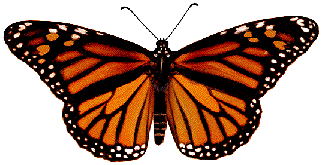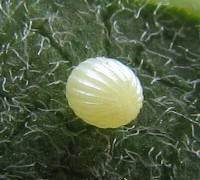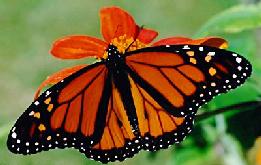 Want to try raising Monarch Butterflies (Danaus plexippus)?
You'll need a hand lens and follow these steps:
Want to try raising Monarch Butterflies (Danaus plexippus)?
You'll need a hand lens and follow these steps:
 First, you'll have to find a milkweed plant where the eggs are laid.
The Common Milkweed (Asclepias syriaca) is probably the easiest
species to find; you can find them growing along roadsides and abandoned
fields. Here's more info on Common Milkweed.
First, you'll have to find a milkweed plant where the eggs are laid.
The Common Milkweed (Asclepias syriaca) is probably the easiest
species to find; you can find them growing along roadsides and abandoned
fields. Here's more info on Common Milkweed.
 Eggs are deposited starting in mid May through the end of August
(at least here in northern Illinois), usually on the
underside of the leaves. The eggs are very small, cone shaped, and
greenish white (or it is said; looks more yellowish to me), with vertical
ridges.
Take the leaf with the egg, and try to shake off any aphids, mites, or other
critters. Store it in a jar with some air holes in the lid and/or side.
A plastic peanut butter jar is OK, though too deep for easy viewing with your
hand lens.
I use a plastic dish that's shallow enough to put the whole thing under a
microscope.
Eggs are deposited starting in mid May through the end of August
(at least here in northern Illinois), usually on the
underside of the leaves. The eggs are very small, cone shaped, and
greenish white (or it is said; looks more yellowish to me), with vertical
ridges.
Take the leaf with the egg, and try to shake off any aphids, mites, or other
critters. Store it in a jar with some air holes in the lid and/or side.
A plastic peanut butter jar is OK, though too deep for easy viewing with your
hand lens.
I use a plastic dish that's shallow enough to put the whole thing under a
microscope.
 The egg hatches within 5 days of being laid; you can tell when the egg is
becoming ripe when it begins to turn translucent and a dark ring (the head
capsule of the embryo) forms at the top. I usually leave the leaf on the
plant for a couple of days if it doesn't look ripe.
The leaf may dry out if you take it off the plant for 4-5 days.
On the other hand, leaving the leaf on the plant
may result in the egg being eaten by something, or hatching before you
come back, so don't leave it out there too long after you find it.
If you need to keep the leaf for more than 1 or 2 days, keep it in a sandwich
bag - do not zip up the top too tight, and be careful not to squash the egg.
The larva hatches by poking its head through the dark spot.
Then it eats the egg "shell";
sometimes it leaves half the shell uneaten, like some spoiled baby.
A dissecting microscope is handy for viewing the action.
The egg hatches within 5 days of being laid; you can tell when the egg is
becoming ripe when it begins to turn translucent and a dark ring (the head
capsule of the embryo) forms at the top. I usually leave the leaf on the
plant for a couple of days if it doesn't look ripe.
The leaf may dry out if you take it off the plant for 4-5 days.
On the other hand, leaving the leaf on the plant
may result in the egg being eaten by something, or hatching before you
come back, so don't leave it out there too long after you find it.
If you need to keep the leaf for more than 1 or 2 days, keep it in a sandwich
bag - do not zip up the top too tight, and be careful not to squash the egg.
The larva hatches by poking its head through the dark spot.
Then it eats the egg "shell";
sometimes it leaves half the shell uneaten, like some spoiled baby.
A dissecting microscope is handy for viewing the action.
The trickiest part is probably transferring the young larva to a new leaf; by this time the old leaf on which it hatched may have shriveled, making it hard to find the tiny baby, who usually crawls to the underside of the leaf to hide from predators. Even after you find it, it's not easy getting the tiny critter to move. What I do is cut a small patch from the old leaf around the egg/larva, and place the patch on a new leaf. Be careful not to cut a big vein when you do this to avoid too much of the gooey "milk".
Also watch for the young larva defecating. Sometimes it has difficulty exuding the frass, and will use its mouth to pull it out, very gross.
 As the baby grows, it will molt 4 times before pupating in
10 to 14 days. Before each molt, it may lie still and stiff for several
hours, then begin to rock and heave to loosen its "inner self" from the old
exoskeleton. You may want to collect the discarded exoskeleton to
observe under the microscope, another gross-out activity.
As the baby grows, it will molt 4 times before pupating in
10 to 14 days. Before each molt, it may lie still and stiff for several
hours, then begin to rock and heave to loosen its "inner self" from the old
exoskeleton. You may want to collect the discarded exoskeleton to
observe under the microscope, another gross-out activity.
 |
The mature caterpillar will crawl to the top and hang upside down in a "J" shape via threads of silk. A transparent lid is ideal for observing how it spins a silken mat in preparation, then hang from the cremaster. Do not disturb the caterpillar while it hangs in the "J" position; if you break the thread which holds up the head end, it may never reach the pupa stage. After about 24 hours in the "J" position, the skin splits and the pupa hardens to form a chrysalis. Make sure you house the last instar caterpillar in a container large enough for the butterfly that emerges later to flap and dry its wings. |  |
 |
It takes about 2 weeks for the metamorphosis. If the pupa falls from its perch, you must hang it up to something; I just tape the cremaster to a pieces of paper and hang the paper to something. After the adult emerges, it needs to hang upside down for a couple of hours to dry its wings, so make sure the container is large enough so its wings do not bump into something; this is where a peanut butter jar comes in handy. The adult also excretes a liquid during this time; if you leave it in a confined space after its wings have dried, it may flop onto the pool of liquid at the bottom and damage its wings, so if you want to observe it for a while, you should move it into a larger space, such as this butterfly cage. You may try to feed the adult with fresh nectar-rich flowers such as Purple Coneflower (Echinacea purpurea), or sugar water, but you should release it within 24 hours. |  |
 | The adult shown at the top of this
page is a female; the one at left is a male, note the pair of scent patches
in the middle of the hind wings on the male.
Photos courtesy of Monarch Watch.
More information on identifying Monarch caterpillar instars, extracted from
The Monarch Larva Monitoring Project, is presented here.
With luck, you can nurture your baby to adulthood and release it as a proud parent, as some students in my Monarch Hall of Fame have done. |
| Author: Peter Chen |